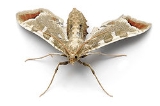
Pyralidae
Overview
The Pyralidae or snout moth
s are a family
of Lepidoptera
in the ditrysia
n superfamily
Pyraloidea
. In many (particularly older) classifications, the grass moths (Crambidae) are included in the Pyralidae as a subfamily, making the combined group one of the largest families in the Lepidoptera. The latest review by Munroe & Solis, in Kristensen (1999) retains the Crambidae as a full family of pyraloidea.
Most of these small moths are inconspicuous and of no particular significance to humans.
Moth
A moth is an insect closely related to the butterfly, both being of the order Lepidoptera. Moths form the majority of this order; there are thought to be 150,000 to 250,000 different species of moth , with thousands of species yet to be described...
s are a family
Family (biology)
In biological classification, family is* a taxonomic rank. Other well-known ranks are life, domain, kingdom, phylum, class, order, genus, and species, with family fitting between order and genus. As for the other well-known ranks, there is the option of an immediately lower rank, indicated by the...
of Lepidoptera
Lepidoptera
Lepidoptera is a large order of insects that includes moths and butterflies . It is one of the most widespread and widely recognizable insect orders in the world, encompassing moths and the three superfamilies of butterflies, skipper butterflies, and moth-butterflies...
in the ditrysia
Ditrysia
The Ditrysia are a natural group or clade of insects in the Lepidopteran order containing both butterflies and moths. They are so named because the female has two distinct sexual openings: one for mating, and the other for laying eggs .About 98% of described species of Lepidoptera belong to Ditrysia...
n superfamily
Superfamily
The term superfamily is used to describe several different concepts in different scientific fields:* Superfamily and Superfamily : a level of biological classification; redirects to Taxonomic rank...
Pyraloidea
Pyraloidea
The Pyraloidea are a moth superfamily containing about 16,000 described species worldwide , and probably at least as many more remain to be described. They are generally fairly small moths....
. In many (particularly older) classifications, the grass moths (Crambidae) are included in the Pyralidae as a subfamily, making the combined group one of the largest families in the Lepidoptera. The latest review by Munroe & Solis, in Kristensen (1999) retains the Crambidae as a full family of pyraloidea.
Most of these small moths are inconspicuous and of no particular significance to humans.
Unanswered Questions

